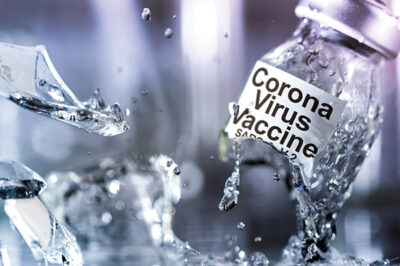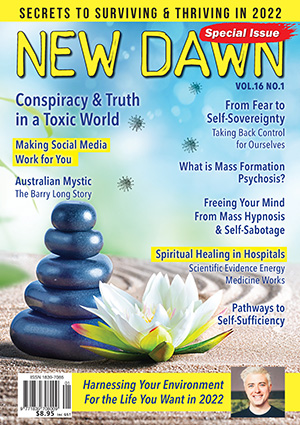From New Dawn Special Issue Vol 16 No 1 (Feb 2022)
In his classic novel Nineteen Eighty-four, author Eric Blair (better known as George Orwell), famously laid out how a totalitarian technocracy would look. The phrase Orwellian has justifiably become an utter cliché, but despite the familiar territory it is worth looking at the aspect of the book that deals with the Ministry of Truth and its employees, who were tasked by the regime with “memory holing” history and rewriting dictionaries (“newspeak”) to reduced language and thus thought to simplistic, binary concepts, such as people and unpeople.
Consider how the definition of “vaccine” has been altered in recent years to appease the designers of mRNA technology. Birmingham and Lambert define vaccination as “the practice of artificially inducing immunity.”1 A book with a foreword written by Bill Gates defines vaccine-induced immunity as follows. “The quality of […] antibody responses, eg, their avidity or specificity, has been identified as a determining factor of efficacy.”
The authors continue: “long-term protection requires the persistence of vaccine antibodies and/or the generation of immune memory cells capable of rapid and effective reactivation with subsequent microbial exposure.”2
But the purported Covid-19 vaccines stimulate antibodies for months at a time, requiring multiple boosters. By a definition endorsed by Gates, the injectable products are not vaccines despite Gates’s use of the term.
The pre-pandemic definition of vaccine has been memory-holed. Putting aside the changes in definition confluent with technological developments, the former definition of vaccine offered by Merriam-Webster was “a preparation… that is administered to produce or artificially increase immunity to a particular disease.”3 The Covid-era definition is: “a preparation that is administered… to stimulate the body’s immune response.”
Notice that the threshold has been lowered from increasing immunity to merely stimulating an immune response. The same big tech that suppresses web search results promotes articles that support the given narrative. In this case, we are being told outright lies: that mRNA is not new, untested technology; that vaccines can indeed be developed within months, not years; that humans are not experimental subjects; and that the injectable products are safe.4
WHEN A TEST IS NOT A TEST
Polymerase chain reactions (PCR) work by amplifying nucleic acids to detect virus particles.
In the late-1980s, virologists were concerned that PCR tests were contaminated by two sources: the carry-over of material from one tube to another and the presence of dead human skin cells. When controlled and uncontrolled PCR tests were compared, the authors of one study found high rates of false-positives.5
A decade later, another study searching for respiratory adenoviruses (Ad) in humans had a 94 per cent efficacy rate when using primers for Ad7 proteins called hexons. But when the primers were not included, the results were much less effective. Detection efficacy for enzyme immunoassays and time-resolved fluroimmunoassys were between 53 and 46 percent.6
Ten years on, Applied Biosystems produced the TaqMan real-time PCR (RT-PCR) which detects viral and bacterial particles via processes called Plus/Minus and Allelic Discrimination. When testing the Plus/Minus to detect Escherichia coli, “an inordinately high proportion of false-positive signals was observed.” Correct thresholds require template controls.7 In one 2015 study using assays, PCR test estimation was over 40 per cent.8
The most common SARS-CoV-2 detector is the Nucleic Acid Amplification Test RT-PCR. “[N]one of the tests have sufficient clinical sensitivity to detect virus during the first several days after infection, nor are they 100% sensitive at the time of peak infectiveness.”9
Recall the late-‘80s PCR test problems mentioned above. In 2020, the same issues plagued the Covid tests: “Technical problems including contamination during sampling (eg, a swab accidentally touches a contaminated glove or surface), contamination by PCR amplicons, contamination of reagents, sample cross-contamination, and cross-reactions with other viruses or genetic material could also be responsible for false-positive results.”10
In addition, the duration of viral infection affects PCR detection ability. The longer the infection, the lower the chances of detection. One kit had an average 77 per cent efficacy (depending on the assays) up to four days. The kit’s efficacy declined to as low as 38 per cent after 10 days of infection.
Footnotes
1. Maureen Birmingham and Claudia Stein, “Global Burden of Disease” in Barry R. Bloom and Paul-Henri Lambert (2003) The Vaccine Book, Elsevier, 3
2. Claire-Anne Siegrist, “Vaccine immunology” in Stanley A. Plotkin, Walter A. Orenstein and Paul A. Offit (eds.) (2013, 6th) Vaccines, Springer, 14
3. Merriam-Webster online, “vaccine,” web.archive.org/web/20201105154809/https://www.merriam-webster.com/dictionary/vaccine
4. Merriam-Webster, “Vaccine,” web.archive.org/web/20211201095040/https://www.merriam-webster.com/dictionary/vaccine
5. P.A. Kitchin, Z. Szotyori, C. Fromholc and N. Almond (1990) “Avoidance of PCR false positives,” Nature, 344: 201
6. R. Räty, M. Kleemola, K. Melén, M. Stenvik and I. Julkunen (1999) “Efficacy of PCR and other diagnostic methods for the detection of respiratory adenoviral infections,” Journal of Medical Virology, 59(1):66-72
7. Forough L. Nowrouzian, Ingegerd Adlerberth, and Agnes E. Wold (2009) “High frequency of false-positive signals in a real-time PCR-based ‘Plus/Minus’ assay,” APMIS, 117(1):68-72
8. David Svec, Ales Tichopad, Vendula Novosadova, Michael W. Pfaffl, and Mikael Kubistaa (2015) “How good is a PCR efficiency estimate: Recommendations for precise and robust qPCR efficiency assessments,” Biomolecular Detection and Quantification, 3: 9-16
9. Glenn D. Braunstein, Lori Schwartz, Pamela Hymel, and Jonathan Fielding (2021) “False Positive Results With SARS-CoV-2 RT-PCR Tests and How to Evaluate a RT-PCR-Positive Test for the Possibility of a False Positive Result,” Journal of Occupational Environmental Medicine, 63(3): e159-62
10. Elena Surkova, Vladyslav Nikolayevskyy, and Francis Drobniewski (2020) “False-positive COVID-19 results: hidden problems and costs,” Lancet, 8(12): 1167-68
© New Dawn Magazine and the respective author.
For our reproduction notice, click here.



